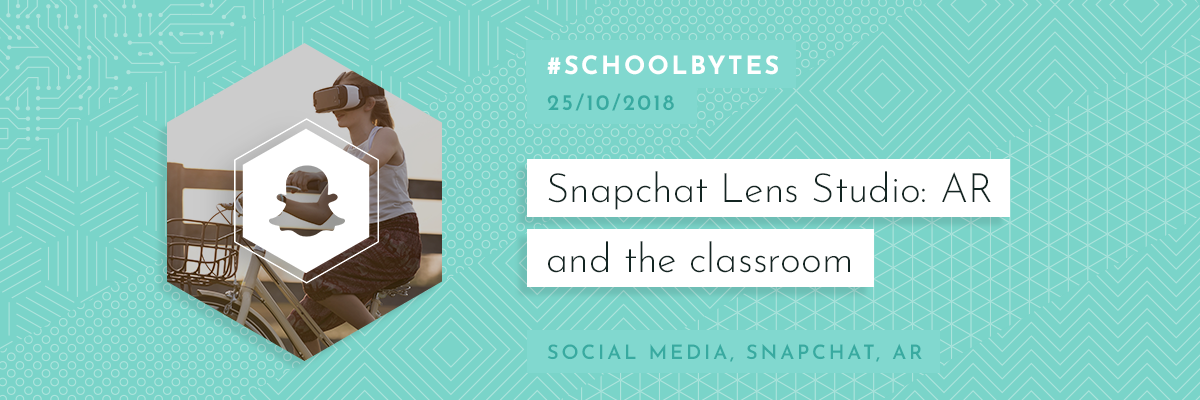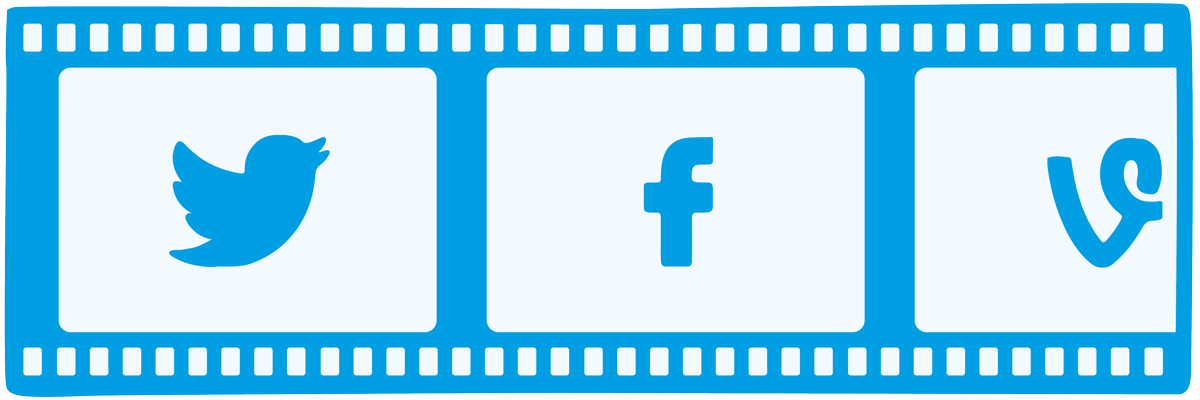Augmented Reality (AR) is the result of using tech to superimpose images, text and sounds on the world that we see. A great example of AR, that many of us will recognise because of its incredible impact back in 2016, is Pokémon GO.
Snapchat Lens Studio: AR and the Classroom
Oct 25, 2018 6:00:00 AM / by Interactive Schools Blog posted in social media, AR, snapchat
How teens use #SocialMedia (written by actual teenagers) [PART 2]
Oct 4, 2016 1:22:19 PM / by Interactive Schools Blog posted in periscope, social media, Pinterest, Flickr, tumblr, vine, linkedin, snapchat
Hi there, and welcome back to this article. Last week we looked at Facebook, YouTube, Twitter, Instagram and Google+.
The list doesn't end there! So, let's continue on from where we left it...
Which social media should I be thinking about this year?
Sep 7, 2016 2:51:35 PM / by Interactive Schools Blog posted in periscope, social media, Instagram, Pinterest, Twitter, google+, Flickr, SoundCloud, youtube, vine, linkedin, snapchat, issuu, facebook
Happy #BackToSchool time everyone!!! Yes, it's the new academic year and you might just be wondering what social media breakthroughs have crept up on you over the summer holidays.
Here is our handy summary of the social media you should be on RIGHT NOW, or at least getting very excited for! So...where shall we begin?
STATS!
Yes, statistics. We all love them - don't lie. These numbers and facts help us to see the reality of how entities such as social media effects us. More importantly they offer guidance in where your school should be driving its social media marketing strategy.
Overall
Social Media Predictions 2016
Jan 6, 2016 7:39:05 PM / by Interactive Schools Blog posted in social media, Twitter, snapchat, facebook
“I look to the future because that’s where I’m going to spend the rest of my life”
Bold and Innovative Ways to Use Social Media in Lessons #EducationDay
Oct 13, 2015 3:19:33 PM / by Interactive Schools Blog posted in social media, Pinterest, Twitter, learning, snapchat, facebook
People mistake social media for socialising. WRONG. People do socialise on social media, but that's just a tiny part of how we use social.
Social is used for learning, collaboration, productivity, writing, curation, entertainment, storytelling. Not just socialising with friends.
Students natively use social media to communicate, curate, and share ideas online.
As teachers, this gives you a great opportunity to increase their passion for learning. Giving access and implementing strong educational resources is a great way to engage students both inside and outside the classroom.
It’s important to incorporate your lesson materials using this new medium. It reaches students through a medium they use everyday. And it also chronicles all the tips, lessons and answers you provide in your stream.
Finding bold and innovative ways to use social media is a great way for your school to progress into this new generation. These are just a few ideas that you can infuse social media into your lesson plans to.
Using Snapchat for Quizzes
Schools are seriously misunderstanding Snapchat, and how people use it. Snapchat is trying to replace TV. It understands that people are moving away from tradition television into YouTube, Netflix, and other mobile channels.
Big media companies (Sky, Daily Mail, National Geographic) have set up their own channels on Snapchat because they understand that's where people are spending their time looking for entertainment.
Because of Snapchat's ephermal nature, teachers can use it for memory quizzes. Simply set the time (1-10 seconds) that you want the image or video to appear, and publish your story to Snapchat.
Why Are Schools Scared of Snapchat?
Sep 17, 2015 8:00:00 AM / by Interactive Schools Blog posted in social media, snapchat
Ah, Snapchat.
It’s full of funny, inappropriate, disappearing photos. In just a few seconds, you can communicate an important message, then have it disappear the next. No wonder kids love using it so much!
In an age where your digital footprint leaves a legacy, Snapchat provides a way to communicate without the worry of future repercussions.
Unfortunately, schools are getting crippled by fear. This is causing them to fall further and further behind in technology awareness and understanding of teenage behaviour.
But why do schools feel so afraid of Snapchat? What’s causing them to turn their backs on a channel that has gained so much popularity among students? Well, it really comes down to one main reason...
Don’t Know How to Use It
Teenagers have this innate ability to understand then adapt to the slang, context, and culture of new social channels. Most schools and educators don’t have that same ability.
A lack of fully understanding the platform leads to fear. Fear that you won’t do it right; fear that something will go terribly wrong; fear that you’ll cause a huge problem for the entire school. And so, it seems better to not use it than to use it wrong.
The Power Of School Stories
Sep 3, 2015 10:23:20 AM / by Interactive Schools Blog posted in social media, Twitter, Flickr, youtube, vine, snapchat, facebook
“We owe it to each other to tell stories.” – Neil Gaiman
From a very young age people are taught such infamous childhood fables as The Boy Who Cried Wolf, The Hare and the Tortoise and The Goose that laid the Golden Eggs.
These fables originate from 620BC and are still taught in schools today!
How many still remember these famous fables? Almost everybody will remember at least one of these infamous fables.
Storytelling began on cave walls and has travelled through time passing through rock art, hieroglyphics, painted artefacts, and has now entered the modern era with social media.
Snapchat, Facebook, Twitter, Vines have stories captured and shared every day. Storytelling hasn’t changed - but the channels we tell them via have evolved.
(The Hare and the Tortoise 1700-2015)
Distributing short videos
Mar 4, 2015 6:33:59 PM / by Interactive Schools Blog posted in meerkat, Instagram, Twitter, youtube, vine, snapchat, facebook
Short form video has exploded recently. With faster 4G speeds, better cameras, and more storage on smartphones, videos have become popular on social media.
A modern parent expects visual storytelling from their school.
Visuals started to be included in posts to make them stand out. But now, everybody does it. Short video has almost become the new photo. Want to stand out? Try posting short videos.
Here are some of the main channels you can use:
As you can see, there are a lot of places you can distribute your short video. So look at the benefits of uploading video to each channel and use this mini-guide to help inform your decision.
YouTube
Second largest search engine in the world. Biggest reach when it comes to video.
Short-form video is not native to YouTube - it was designed, and is being used, for longer form.
Share to YouTube if your video is over 1 minute.
Vine
Vine is designed for creating 6-second videos on mobile. So it is native for distributing short video.
The restrictive nature of Vine forces you to be creative with your posts. Which has led Vine to be popular with people who want quick entertainment.
Posts can easily be embedded into tweets, and websites to increase your reach.
Instagram has a huge audience of over 300 million people. It is a mobile-first platform, meaning it is designed to capture events through your smartphone.
There is a 15 second limit on videos.
Share artsy and indie photos to engage the Instagram crowd. Don’t put adverts, or text based content up.
A video posted by bablakeofficial (@bablakeofficial) on
Facebook has the largest audience, second only to YouTube. But, it is not a video specific channel.
Facebook autoplays videos in a person’s feed. Though this is great for grabbing attention, it also inflates the number of views a video has had in Facebook Insights.
Facebook videos are for short-medium form video. No real purpose for Facebook videos - other than to be more of a competitor to YouTube.
Sharing videos on Facebook, from YouTube, creates a link post. This pulls through meta data from YouTube, and isn’t as effective or attention-grabbing as native Facebook video. Also means it requires more clicks to play the video.
Videos can be uploaded once they have already been taken. This allows you to capture moments and share them at the end of the day.
If you have time to upload videos to Facebook, then go for it. If not, share it to YouTube.
Twitter is naturally all about short storytelling. The strict limitations on Twitter enables you to share quick micro-content.
It has recently introduced video to tweets, with a 30 second limit.
Twitter owns Vine. The difference? Vine is a creative way to tell your story. Twitter is the real-time way to tell your story.
You can now shoot, edit and share video on Twitter. Capture life’s most moving moments from your perspective. pic.twitter.com/31JoMS50ha
— Twitter (@twitter)
Snapchat
Mobile video is native to Snapchat. It allows you to capture a moment, as it is happening, and share it to your ‘story’. Your story is a collection of photos and videos capture with Snapchat in the past 24 hours.
There is a 10 second limit for each video but you can piece them together in your story.
Snapchat is more like the front of a postcard, where Twitter is the back.
Meerkat (NEW)
Meerkat is a live broadcasting platform that allows you to stream video through Twitter. It literally went live 6 days ago (that’s how quickly we react for you guys!).
The platform is all about sharing live stories. How can you get more real-time than that?!
Take a look at it and explore it. What do you think?
There are clear pros and cons for distributing short videos on particular channels. You can repurpose videos to work for each channel - but only if they work with the style of each channel.
QUESTION OF THE DAY: If you could only upload your latest video to ONE channel, which would you choose and why? TWEET US: @intSchools
Social Media Training Day #SMTD15
We’re offering a social media day for school marketers to learn more about social media marketing. Come and join us on 28th April 2015 at Whittlebury Hall, Northamptonshire.
Learn about reach, social influence and the importance of your digital brand.








